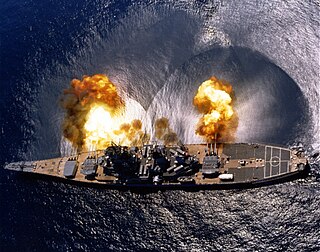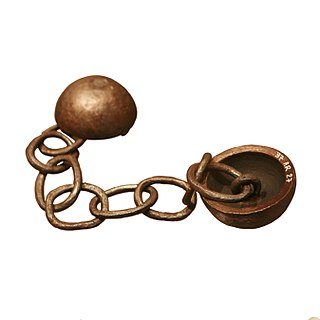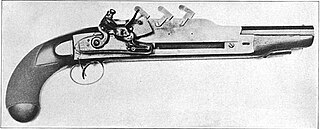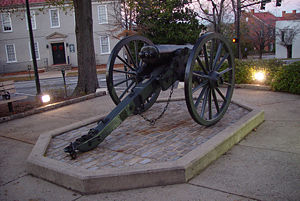
A double-barreled shotgun, also known as a double shotgun, is a break-action shotgun with two parallel barrels, allowing two single shots that can be fired simultaneously or sequentially in quick succession.

A machine gun (MG) is a fully automatic, rifled auto-loading firearm designed for sustained direct fire with rifle cartridges. Other automatic firearms such as automatic shotguns and automatic rifles (including assault rifles and battle rifles) are typically designed more for firing short bursts rather than continuous firepower and are not considered true machine guns. Submachine guns fire handgun cartridges rather than rifle cartridges, therefore they are not considered machine guns, while automatic firearms of 20 mm (0.79 in) caliber or more are classified as autocannons rather than machine guns.
A muzzleloader is any firearm in which the user loads the projectile and the propellant charge into the muzzle end of the gun. This is distinct from the modern designs of breech-loading firearms, in which user loads the ammunition into the breech end of the barrel. The term "muzzleloader" applies to both rifled and smoothbore type muzzleloaders, and may also refer to the marksman who specializes in the shooting of such firearms. The firing methods, paraphernalia and mechanism further divide both categories as do caliber.

In firearms terminology, an action is the functional mechanism of a breech-loading firearm that handles the ammunition cartridges, or the method by which that mechanism works. Actions are technically not present on muzzleloaders, as all those are single-shot firearms with a closed off breech with the powder and projectile manually loaded from the muzzle. Instead, the muzzleloader ignition mechanism is referred to as the lock.

The pepper-box revolver or simply pepperbox is a multiple-barrel firearm, mostly in the form of a handgun, that has three or more gun barrels in a revolving mechanism. Each barrel holds a single shot, and the shooter can manually rotate the whole barrel assembly to sequentially index each barrel into alignment with the lock or hammer, similar to rotation of a revolver's cylinder.

A breechloader is a firearm in which the user loads the ammunition from the breech end of the barrel, as opposed to a muzzleloader, in which the user loads the ammunition from the (muzzle) end of the barrel.

Canister shot is a kind of anti-personnel artillery ammunition. Canister shot has been used since the advent of gunpowder-firing artillery in Western armies. However, canister shot saw particularly frequent use on land and at sea in the various wars of the 18th and 19th century. Canister is still used today in modern artillery.

A volley gun is a gun with multiple single-shot barrels that volley fired simultaneously or sequentially in quick succession. Although capable of unleashing intense firepower, volley guns differ from modern machine guns in that they lack autoloading and automatic fire mechanisms, and therefore their volume of fire is limited by the number of barrels bundled together.

Naval artillery is artillery mounted on a warship, originally used only for naval warfare and then subsequently used for more specialized roles in surface warfare such as naval gunfire support (NGFS) and anti-aircraft warfare (AAW) engagements. The term generally refers to powder-launched projectile-firing weapons and excludes self-propelled projectiles such as torpedoes, rockets, and missiles and those simply dropped overboard such as depth charges and naval mines.

The hand cannon, also known as the gonne or handgonne, is the first true firearm and the successor of the fire lance. It is the oldest type of small arms as well as the most mechanically simple form of metal barrel firearms. Unlike matchlock firearms it requires direct manual external ignition through a touch hole without any form of firing mechanism. It may also be considered a forerunner of the handgun. The hand cannon was widely used in China from the 13th century onward and later throughout Eurasia in the 14th century. In 15th century Europe, the hand cannon evolved to become the matchlock arquebus, which became the first firearm to have a trigger.

Field artillery in the American Civil War refers to the artillery weapons, equipment, and practices used by the Artillery branch to support the infantry and cavalry forces in the field. It does not include siege artillery, use of artillery in fixed fortifications, or coastal or naval artillery. Nor does it include smaller, specialized artillery classified as small arms.

In artillery, chain shot is a type of cannon projectile formed of two sub-calibre balls, or half-balls, chained together. Bar shot is similar, but joined by a solid bar. They were used in the age of sailing ships and black powder cannon to shoot masts, or to cut the shrouds and any other rigging of a target ship.
Naval artillery in the Age of Sail encompasses the period of roughly 1571–1862: when large, sail-powered wooden naval warships dominated the high seas, mounting a large variety of types and sizes of cannon as their main armament. By modern standards, these cannon were extremely inefficient, difficult to load, and short ranged. These characteristics, along with the handling and seamanship of the ships that mounted them, defined the environment in which the naval tactics in the Age of Sail developed.

A handgun is a firearm designed to be usable with only one hand. It is distinguished from a long gun which needs to be held by both hands and braced against the shoulder. Handguns have shorter effective ranges compared to long guns, and are much harder to shoot accurately. While most early handguns are single-shot pistols, the two most common types of handguns used in modern times are revolvers and semi-automatic pistols, although other handguns such as derringers and machine pistols also see infrequent usage.
A paper cartridge is one of various types of small arms ammunition used before the advent of the metallic cartridge. These cartridges consisted of a paper cylinder or cone containing the bullet, gunpowder, and in some cases, a primer or a lubricating and anti-fouling agent. Combustible cartridges are paper cartridges that use paper treated with oxidizers to allow them to burn completely upon ignition.

A potato cannon is a pipe-based cannon that uses air pressure (pneumatic), or combustion of a flammable gas, to launch projectiles at high speeds. They are built to fire chunks of potato, as a hobby, or to fire other sorts of projectiles, for practical use. Projectiles or failing guns can be dangerous and result in life-threatening injuries, including cranial fractures, enucleation, and blindness if a person is hit.

A superposed load or stacked charge or superimposed load is a method used by various muzzle-loading firearms, from matchlocks to caplocks, including a few modern weapons, such as Metal Storm, to fire multiple shots from a single barrel without reloading. In a sense, superposed load guns were the first automatic firearms, as they fired multiple shots per pull of the trigger.

A multiple-barrel firearm is any type of firearm with more than one gun barrel, usually to increase the rate of fire or hit probability and to reduce barrel erosion or overheating.
The Wyatt Family was featured on the American reality TV show American Guns. Rich Wyatt ran a gun store called Gunsmoke Guns which was the main setting for the American Guns show. He operated the store with his family: Renee his wife, his stepdaughter Paige Wyatt, and his stepson Kurt Wyatt, along with the many other employees of Gunsmoke. The store lost its firearms license in April 2012, though continued to trade allegedly booking the sales whilst directing purchasers to another store to fill in checks and complete the sale. Rich Wyatt was found guilty of charges related to this activity and tax evasion in 2017, and was sentenced to 78 months in prison.

A repeating firearm or repeater is any firearm that is capable of being fired repeatedly before having to be manually reloaded with new ammunition into the firearm.


















